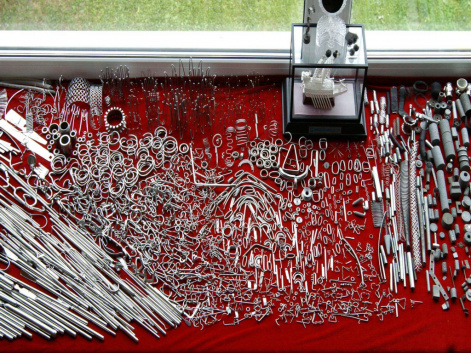Metal instead of bone: Siberian scientists are using shape-memory materials for effective surgery
30 September 2019 г.

Very often, during surgical interventions, doctors have to restore or change the shape of the patient’s bone and other tissues using different materials. These materials are divided into biological (transplant) and artificial (implant) ones. For many years, biological materials were believed to be more suitable for medical purposes. However, their use is not without drawbacks. They are often obtained from the patient’s tissues, with another surgical injury being inflicted on a patient. With this approach, it is also impossible to create transplant products of a given shape. Another option is transplants from dead, “alien” tissues. However, the patient’s body may reject them.
The revolution in surgery occurred with the invention of artificial implants and use of metallic materials with shape memory effect. These include titanium nickelide implants. Conventional titanium materials are stiff. Titanium is twenty times less elastic than bone tissue, which it is to replace, and cannot provide the necessary elasticity of the replaced parts of the body. The fact is that in the body the implants are constantly under load, to which they must adapt. If they are not flexible enough, they will be rejected because the body "understands" that the implanted material is not functioning properly.
Titanium nickelide is deformed and restored to its original form during load and unload. Titanium nickelide products are not rejected also because they do not enter into chemical reactions with human biological fluids. It is important that the patient does not need to be subjected to additional injury to obtain such products. This material also contributes to the growth of the patient’s own tissue at the site of damage.
In a critical review published in the journal Materials, scientists pointed out that titanium nickelide withstands numerous consecutive strains while maintaining its integrity. The researchers note that bone tissue behaves in a similar way. This material transfers most of the physical stress through redistributed hydrostatic pressure, as cancellous bone tissue does. This effect is important when replacing the femur, tibia and lumbar vertebrae, since it is these parts that account for the highest load.
In recent years, scientists from several Siberian cities, including the Krasnoyarsk Science Center SB RAS, have registered more than 60 patents on the creation of various products based on this material. The peculiarity of titanium nickelide implants is that they can take almost any shape with regard to individual characteristics of the patients. Siberian doctors suggest using this material in dentistry, traumatology, osteoplasty, jaw and vascular surgery as well as reconstructive and cosmetic ones in order to eliminate congenital clefts, hernias of the anterior abdominal wall and many other problems. There are no restrictions on the application of this material in surgery, nor are there any physical limitations in the lives of patients due to such implants.
“The material can interact with different biological tissues. Implants made of this material can have various structures: monolithic or porous, textile or mesh one. If necessary, the latter three can be made using organotypic tissue culture. This makes surgery the most effective, ” explains Andrei Radkevich, Doctor of Medical Sciences, professor, leading research associate at the Institute of Medical Problems of the North KSC SB RAS.
In one of the latest patents, scientists from Tomsk and Krasnoyarsk proposed a new method for using products made of shape memory material. It should facilitate the treatment of patients with nonunion and false joints of long tubular bones. In such cases, the continuity of the bone is disrupted in patients and there appears mobility in the areas wh ere it should not be observed. This leads to anatomical and functional disorders, for example, to circulatory failure in limbs, scarring of soft tissues, limitation of mobility, deformation or shortening of the damaged bone.
This problem occurs in about one in ten cases with fractures of the tubular bones. The methods of bone grafting used earlier to eliminate this defect are not effective enough. The scientists suggested using porous permeable implants for these purposes, including granular implants, fixing structures, as well as mesh implants made of titanium nickelide. The researchers note that improving the method of treatment with the application of shape memory materials will significantly increase the effectiveness of rehabilitation.
Exceptional properties make shape memory materials very promising for the application in various branches of medicine. Their use depends directly on the goals and objectives of the ongoing rehabilitation measures, according to which titanium nickelide materials can be transformed to the needs of surgeons and patients.
Share:
